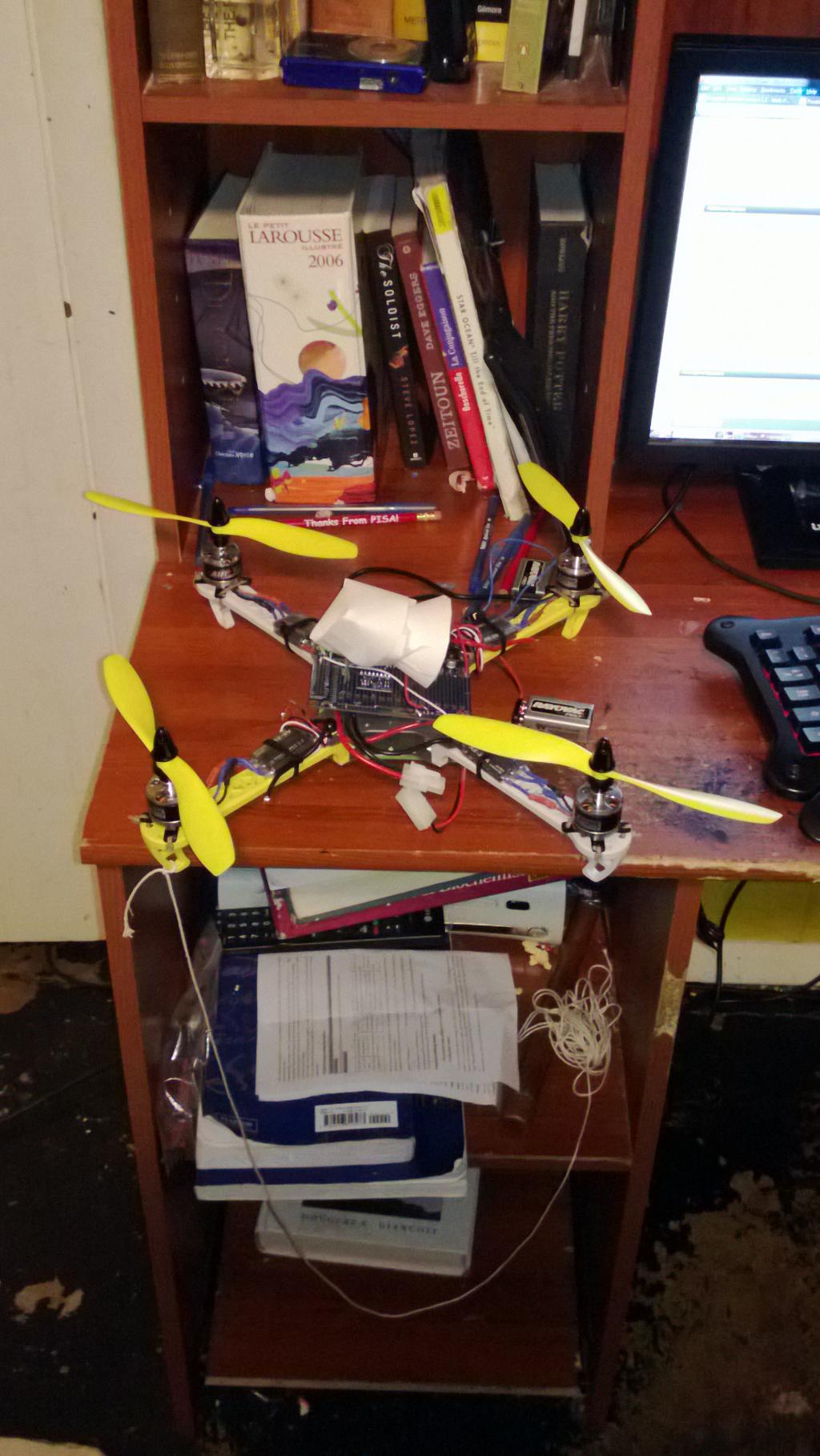ESCs and the Propeller
I'm a member of a student engineering team, and we're working to build a quadcopter. Currently what we have set up is four Turnigy 2210A motors wired to four Turnigy AE-20A ESCs. Although two of the four ESCs shipped faulty, we still want to have the other two rotors spin for the sake of show at our presentation next week. We're having some trouble programming the ESCs though. I think a large part of our difficulty comes from our inexperience with the way that parts made for RC work (the entire team only has experience with rather basic digital electronics), so I figured it couldn't hurt to ask the community.
The manual for the ESCs says that to enter the programming menu, you set the throttle to the full position (Does this not mean a constant stream of 1's?), and then connect the battery to the ESC. It should then make a sort of "ding-ding-ding
ding-ding-ding-ding-ding
warble-warble" set of sounds.
Just giving the ESC a constant stream of 1's fails to make it entire into the programming menu. A stream of 101010101010 (equal frequency) makes it enter into programming mode, but if that is high, I don't know what the low throttle signal should look like.
I guess my question is, if I'm trying to emulate the signals that a RC transmitter would send, what do the full throttle and low throttle signals look like?
Attached is a picture of the current build just in case.
The manual for the ESCs says that to enter the programming menu, you set the throttle to the full position (Does this not mean a constant stream of 1's?), and then connect the battery to the ESC. It should then make a sort of "ding-ding-ding
ding-ding-ding-ding-ding
warble-warble" set of sounds.
Just giving the ESC a constant stream of 1's fails to make it entire into the programming menu. A stream of 101010101010 (equal frequency) makes it enter into programming mode, but if that is high, I don't know what the low throttle signal should look like.
I guess my question is, if I'm trying to emulate the signals that a RC transmitter would send, what do the full throttle and low throttle signals look like?
Attached is a picture of the current build just in case.



Comments
When you say two of the ESCs shipped faulty, how do you know? Are you using a RC receiver to control them?
I see a 9V battery in the picture. I hope you're not trying to power the ESCs (or servos) with it.
What kind of Propeller board do you have? If it's a QuickStart, you could try out my QuickStart servo tester. You could use it to control both servos and ESCs.
Edit: I see you're using a Propeller Project board. The 9V batteries concern me. Your ESC is very unlikely to work being powered by a one of those batteries. If you use multiple battery packs make sure they all share a common ground connection. Post #15 of my QuickStart servo tester thread has a very simple servo demo program. You may want to try it out.
BTW, Full throttle is normally a 2000us pulse at 50Hz. Low throttle is usually a 1000us pulse at 50Hz. (Or reverse of what I just stated depending on the brand of equipment.)
The two faulty ESCs do not produced a tone when hooked up like the working two do.
The 9V powers the Project Board, the motor battery is on the bottom of the frame, it might be hard to see.
Reading that, I see that there is a driver written for servos. I'll start getting familiar with it.
Thanks for the tip about the grounds, I'll make that connection right away.
I'll try these values with the servo driver in the propeller library
Hooked up to what and how were they connected?
The ESCs don't have a way of producing a tone on their own. They use the motors to produce the beeps (I was surprised when I was told this fact).
I'm not sure it's really fair to call an ESC faulty without testing it with a working RC tx and rx system.
What are you going to use as a controller?
Has anyone on your team flown quadcopters or helicopters before? If not, you may want to get a small quadcopter or flight simulator to practice on. A flight simulator will pay for itself several times over in saved parts. I wish they had RC flight simulators when I started learning to fly RC aircraft.
Also, looking at your quad, you're going to have a bugger of a time controlling yaw. You need to mount the matching propellers diagonally opposite each other, and right now you appear to have them paired left to right. Yaw control is attained by speeding up the clockwise pair and slowing down the counter-clockwise pair, so if they aren't diagonally opposite each other, they'll impart a pitch or roll instead of a yaw.
And what Duane says about a simulator or a practice quad is spot on. These things most certainly do not fly themselves without a LOT of work. If you're looking to make it autonomous you should have it well tethered until you're quite sure it works as expected. If you're making it to be piloted, get some practice first so you'll be able to handle it when it goes wrong.
Jason has a really good set of eyes. I had to enlarge the picture and study it carefully to see this.